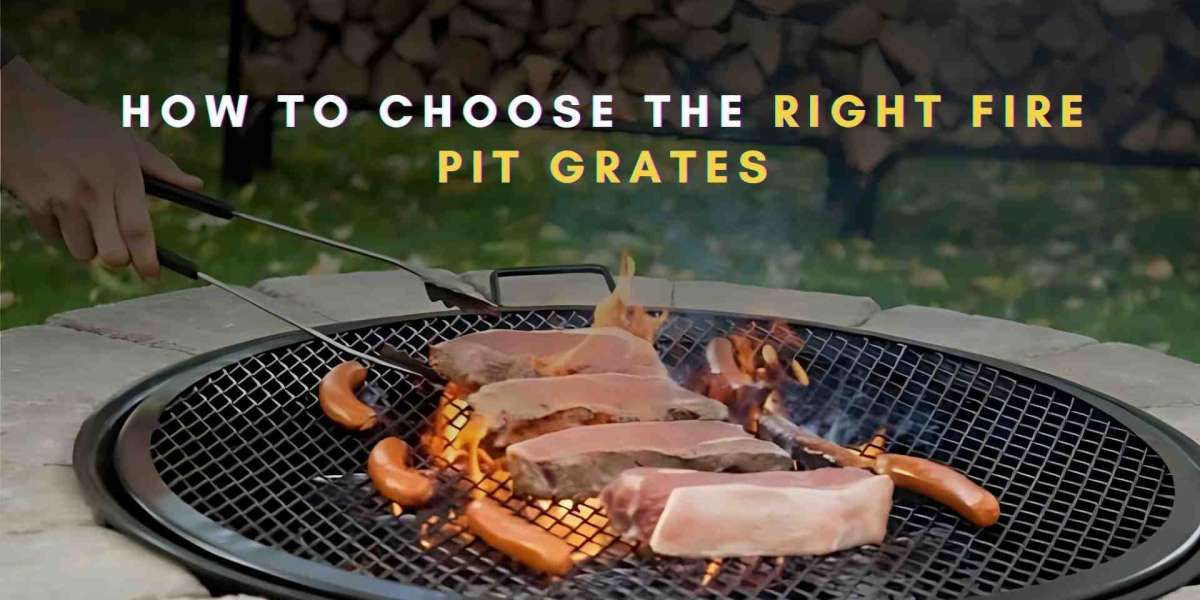Fire pits are more than just a source of warmth—they unite people, offering a perfect centerpiece for outdoor gatherings. While the fire takes center stage, the components that support it, such as fire pit grates, play a critical role in ensuring the fire burns efficiently and safely. Grates enhance airflow, improve combustion, and protect the fire pit's base, making them indispensable for functionality and longevity. Choosing the proper grate can differentiate between a smoky, inconsistent fire and a clean, warm blaze. This guide will walk you through everything you need to know about selecting the perfect fire pit grate for your needs.
Understanding Fire Pit Grates
Fire pit grates are sturdy metal frameworks designed to elevate wood or charcoal above the base of a fire pit. By lifting the fuel, grates allow air to circulate freely underneath, fueling combustion and reducing the smoke produced. Available in various shapes, sizes, and materials, these grates can accommodate diverse fire pit designs and preferences.
Benefits of Using a Fire Pit Grate
Investing in a quality fire pit grate comes with several advantages:
- Improved Airflow: The elevation allows oxygen to flow beneath the fuel, feeding the fire and ensuring a hotter, cleaner burn.
- Protection for the Fire Pit Base: By keeping logs and coals off the fire pit's surface, grates prevent direct heat damage, extending the lifespan of the fire pit.
- Reduced Smoke: Enhanced combustion reduces incomplete burning, which is the primary cause of excessive smoke.
- Safer Fires: Grates keep logs securely in place, minimizing the risk of them rolling out of the fire pit.
Materials Used in Fire Pit Grates

When choosing a fire pit grate, the material is essential because it affects how long it will last, how well it works, and how much upkeep it needs.
- Cast Iron: Cast iron grates are prized for their strength and ability to retain heat. They are ideal for frequent users who require a robust solution. However, they may rust if not correctly maintained.
- Steel: A more affordable option, steel grates are durable and functional. They may require rust prevention treatments to ensure longevity.
- Stainless Steel: Stainless steel grates are highly resistant to rust and weathering, making them perfect for outdoor use in all climates. Though more expensive, they are a worthwhile investment for longevity and low maintenance.
Shapes and Sizes of Fire Pit Grates
Fire pit grates come in various shapes and sizes to fit different fire pits.
- Round Grates: Perfect for circular fire pits, these grates provide even heat distribution and are among the most commonly used.
- Square and Rectangular Grates: Ideal for fire pits with straight edges or larger sizes, these grates offer versatility and a modern look.
- Hexagonal Grates: For those who value aesthetics, hexagonal grates provide a unique design that stands out while offering excellent performance.
Choosing the correct size is essential. Measure your fire pit's inner dimensions and leave a one-inch clearance around the edges to ensure proper fitting and easy installation.
Factors to Consider When Choosing Fire Pit Grates
Selecting the right fire pit grate involves evaluating several factors:
- Size Compatibility: Ensure the grate matches the dimensions of your fire pit. Oversized grates may not fit, while undersized ones may be unstable.
- Material Durability: Depending on your usage and climate, select a material that balances durability and maintenance requirements.
- Weight Capacity: If you plan to burn heavy logs, choose a grate with a high weight capacity to avoid bending or damage.
- Ease of Maintenance: Opt for materials like stainless steel if you prefer minimal upkeep.
How to Measure Your Fire Pit for a Grate
To choose the proper grate, you need to have accurate measures. To make sure it fits right, do these things:
- Measure the Diameter or Width: For circular fire pits, measure the interior diameter. For square or rectangular pits, measure the width and length.
- Account for Clearance: Subtract one inch from your measurement to allow space around the grate.
- Depth Consideration: Ensure the grate won't sit too high or too low within the fire pit, which can affect airflow and performance.
Avoid common mistakes like measuring the outer dimensions of the fire pit instead of the inner, as this can lead to incorrect sizing.
Maintenance Tips for Fire Pit Grates

If you take good care of and maintain your fire pit grate, it will last a lot longer:
- Regular Cleaning: After each use, remove ash and debris to prevent buildup. Use a wire brush to scrub off soot for cast iron or steel grates.
- Rust Prevention: Apply a high-temperature-resistant coating or oil to steel and cast iron grates to protect them from moisture.
- Storage: When not in use, store the grate in a dry place or use a cover to shield it from the elements.
These simple steps will ensure your grate remains in top condition for years.
Fire Pit Grate Accessories
Enhance your fire pit experience with valuable accessories:
- Log Tongs: Safely arrange logs without risking burns.
- Ash Pans: Make cleanup more convenient by collecting ash below the grate.
- Fire Poker: A versatile tool for adjusting the fire and ensuring consistent burning.
Additionally, arranging wood in a crisscross pattern on the grate allows for better air circulation and even burning, maximizing the efficiency of your fire pit.
Choosing the right fire pit grate is essential for creating a safe, efficient, and enjoyable outdoor fire experience. By understanding the various materials, shapes, sizes, and features available, you can find a grate that perfectly complements your fire pit and meets your specific needs. From enhancing airflow and combustion to protecting your fire pit’s base, a well-chosen grate is a valuable investment in functionality and longevity.
FAQs
1. What is the best material for fire pit grates?
Stainless steel is the best choice because it doesn't rust and lasts long.
2. Can I use a fire pit grate for charcoal?
Yes, most fire pit grates are suitable for both wood and charcoal.
3. How often should I clean my fire pit grate?
Clean your grate after every use to remove ash and prevent buildup.
4. What size fire pit grate do I need?
Measure your fire pit's inner dimensions and leave a one-inch clearance around the grate.
5. How can I prevent my grate from rusting?
Apply high-temperature coatings and store the grate in a dry place when not in use.














